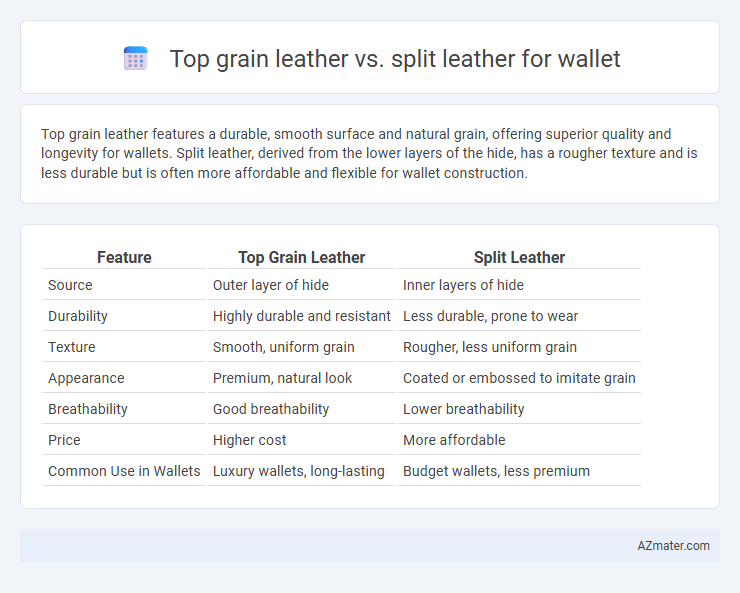Top grain leather features a durable, smooth surface and natural grain, offering superior quality and longevity for wallets. Split leather, derived from the lower layers of the hide, has a rougher texture and is less durable but is often more affordable and flexible for wallet construction.
Table of Comparison
| Feature | Top Grain Leather | Split Leather |
|---|---|---|
| Source | Outer layer of hide | Inner layers of hide |
| Durability | Highly durable and resistant | Less durable, prone to wear |
| Texture | Smooth, uniform grain | Rougher, less uniform grain |
| Appearance | Premium, natural look | Coated or embossed to imitate grain |
| Breathability | Good breathability | Lower breathability |
| Price | Higher cost | More affordable |
| Common Use in Wallets | Luxury wallets, long-lasting | Budget wallets, less premium |
Understanding Top Grain Leather
Top grain leather, sourced from the upper layer of the hide, offers superior durability and a smooth, refined finish ideal for high-quality wallets. It undergoes minimal sanding and buffing, preserving natural grain patterns that enhance breathability and resistance to wear. This leather type outperforms split leather, which originates from the lower layers and lacks the strength and aesthetic appeal crucial for long-lasting wallet craftsmanship.
What is Split Leather?
Split leather is derived from the lower layers of a hide after the top grain has been separated, making it less durable and less expensive than top grain leather. Unlike top grain leather, split leather lacks the natural grain and strength, often requiring a synthetic coating to enhance its appearance and durability for wallet construction. Wallets made from split leather offer a budget-friendly option but typically do not match the longevity or premium feel of those crafted from top grain leather.
Durability: Top Grain vs Split Leather
Top grain leather offers superior durability for wallets due to its dense fiber structure and resistance to wear, making it less prone to cracking and aging over time. Split leather, derived from the lower layers of the hide, has a looser fiber arrangement, resulting in reduced strength and higher susceptibility to scuffing and tearing. For long-lasting wallet use, top grain leather provides enhanced longevity and maintains its appearance better under daily stress.
Appearance and Texture Comparison
Top grain leather exhibits a smooth, refined appearance with a natural grain that enhances its luxurious texture, making it ideal for premium wallets. Split leather, derived from the lower layer of the hide, presents a rougher, more porous surface that is often embossed to mimic top grain, resulting in a less natural look and feel. The durability and softness of top grain leather provide a superior tactile experience compared to the more rigid and coarse texture of split leather.
Wallet Longevity: Which Lasts Longer?
Top grain leather offers superior durability and ages gracefully, making it ideal for wallets that endure daily wear and tear. Split leather, derived from the lower layer of the hide, lacks the strength of top grain leather and is more prone to cracking and peeling over time. Wallets crafted from top grain leather generally maintain their structure and appearance significantly longer, ensuring better longevity.
Price Difference Explored
Top grain leather wallets typically command higher prices due to superior durability, smooth texture, and higher quality processing, which enhances their aesthetic appeal and longevity. Split leather wallets, made from the fibrous lower layers of hide, are generally more affordable but offer less durability and a rougher texture, often requiring additional bonding or coating to improve appearance. The price difference between top grain and split leather wallets reflects the trade-off between cost and quality, making top grain a preferred choice for premium, long-lasting wallets.
Maintenance and Care Tips
Top grain leather wallets require less frequent conditioning due to their durable surface, making them easier to maintain and resistant to stains and scratches. Split leather wallets need regular moisturizing to prevent drying and cracking, as their fibrous texture absorbs more moisture and dirt. Using specialized leather cleaners and conditioners tailored to each type enhances longevity and preserves the wallet's appearance.
Environmental Impact and Sustainability
Top grain leather, derived from the outer layer of the hide, is more durable and requires fewer chemical treatments than split leather, resulting in a lower environmental impact in wallet production. Split leather originates from the fibrous lower layers of the hide, often necessitating heavy processing and synthetic coatings that increase its carbon footprint and reduce overall sustainability. Choosing wallets made from top grain leather supports longer product lifespan and conserves resources, aligning with eco-friendly and sustainable consumption practices.
Popular Brands Using Each Type
Top grain leather, known for its durability and smooth finish, is favored by popular brands like Coach and Fossil for wallet craftsmanship, offering a premium feel and long-lasting wear. Split leather, often used by brands such as Timberland and Levi's, provides a more affordable option with a suede-like texture but is less durable compared to top grain. Consumers seeking luxury and resilience often choose wallets made from top grain leather, while those prioritizing budget-friendly style may opt for split leather options.
Which Leather is Best for Your Wallet?
Top grain leather is the best choice for wallets due to its durability, smooth texture, and natural resistance to wear and tear, offering a high-quality finish that improves with age. Split leather, made from the lower layers of the hide, is less durable and more prone to stretching and damage, often treated with synthetic coatings to mimic higher quality leathers. For a long-lasting, premium wallet, top grain leather provides superior strength, longevity, and aesthetic appeal compared to split leather.

Infographic: Top grain leather vs Split leather for Wallet
 azmater.com
azmater.com